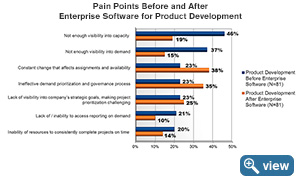
This blog kicks off a series of posts featuring the six characteristics of mature organizations in the areas of capacity planning and resource management.
Based on a new research study into the state of capacity planning and resource management at large companies, six traits emerged that more mature companies share. I’ve listed them here and I’ll dive into more detail on the first trait in today’s blog post.
Organizations that excel at capacity planning and resource management:
- Have insight into what people are working on, can identify bottlenecks, and run scenarios on-demand to adapt to change
- Meld top-down with bottom-up approaches to capacity planning and resource management
- Have a dedicated function to run resource management and capacity planning activities
- Agree on these top best practices: prioritization; what-if analysis; executive buy-in
- Estimate project well and have good supporting processes in place
- Use project portfolio management software to optimize their resources
Characteristic #1: Mature organizations have insight into what people are working on, quickly identify bottlenecks, and have the capability to run on-demand what-if scenarios to adapt to change.
Insight and visibility are the foundation of managing demand and capacity. Consider this: Can you easily identify: products or projects your resources are working on, their skills, who’s sitting on the bench, or who may be assigned more work than they can handle? If your answer is no, you’re not alone.
According to the report, a surprising number of product organizations consider lack of visibility into resources as one of their top frustrations. We found that visibility and addressing some specific areas of process and technology was directly correlated with advancement in maturity.
At the most basic or ad-hoc level of maturity, visibility is virtually non-existent and managers are unable to view workload and activities from a resource perspective; therefore, they lack a clear picture into capacity or demand. As they move up to the mid-tier of the maturity scale, they achieve basic visibility into what resources are working on, but they have a limited view into the time when resources become available again. Imagine trying to staff a complex, expanding product line under these conditions (maybe this is your reality). It can’t be easy and it leads to a variety of bottlenecks and over commitments.
Let’s look at other practices of more mature organizations:
- Planning Process
Mature organizations have an effective planning process with visibility into role-level demand before work is committed. They have the processes and technology in place to enable everyone to capture information consistently in a repeatable way. In fact, lack of process is the top cause of this pain but decreases by at least 10-20% as companies move up the maturity scale. In correlation, the lack of visibility drops by 15-20% for more mature companies. These processes may include how and where project managers and resource managers report information, use of time sheets, and progress reported against product timelines.
- Technology
On the technology front, 60% of lower maturity organizations reported that the underlying cause of this problem is their reliance on spreadsheets and basic project management tools that can no longer handle the resource complexities facing today’s product organizations. In lower maturity companies, information remains in the heads of product development managers and resource managers or it is living in un-integrated spreadsheets on their desktop providing little to no visibility into resource availability and utilization.
While nearly 70% of lower maturity companies rely on spreadsheets and basic project software, the most mature companies have implemented product portfolio management software (PPM). Companies who use enterprise software experienced a 27% and 22% visibility improvement into capacity and demand respectively.
- Managing in the face of constant change
Related to the challenge of visibility, the top pain point for 47% of survey takers is the issue of constant change. This is another area where more mature companies shine in comparison to the lower maturity group. The more mature company not only has visibility into resources but also the on-demand data needed to perform what-if scenarios helping them to play-out the impact of changing priorities and market shifts on their resources. For example, if a competitor introduces a new product to the market and the company needs to respond, leaders can see how decisions and shifts in resources would impact various products or projects. All too often, these changes are made without a view into the downstream affects that can result. Again, similar approaches to process and technology are needed to attain visibility and access to real-time data that drives business decisions.
The lesson here is that visibility is paramount to success and it’s possible to get better access to it. To get there, companies need the right software, such as a PPM solution, to capture information and a commitment to implement best practices and process to do it consistently. This investment is critical to improving time to market and moving up the maturity model.
Quotes from participants who summed it up well:
“When we started, we had a huge problem with visualization of data. Now that we have software and processes, we are in much better shape and now we’re working to mature beyond visibility.”
— Program Manager, Consumer Goods Product Company
“Our biggest challenge is to react to changing demand, which is very important. It is ever changing and the average planner has to have the right tools to manage it.”
— Program Manager- Large Clinical Resource Organization
Stay tuned for the #2 Characteristic of Mature Organizations: Melding top-down and bottom-up approaches to capacity planning and resource management.
I’d like to hear from you. What are some of the methods you use to gain insight into what your valuable resources are working on?





